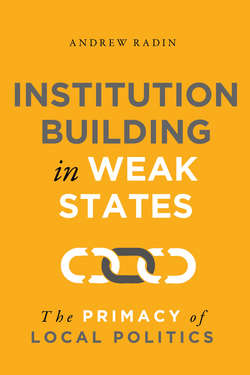Читать книгу Institution Building in Weak States - Andrew Radin - Страница 12
На сайте Литреса книга снята с продажи.
WHY STUDY INSTITUTION BUILDING?
ОглавлениеAfter US-led interventions in the Balkans, Afghanistan, and Iraq, an extensive literature has developed to study these efforts, and there are growing doubts of the merits of future intervention. Still, institution building deserves further study. It is an essential component of US and international policy, and the existing literature has not offered insight into the critical question of how the choice of demands and recommendations influence reform success.
Even after the drawdowns from Iraq and Afghanistan, institution building remains an important element of US foreign policy because it is rarely practical or efficient for US organizations to address threats without the help of allied or partner organizations. Building partner capacity is a central component of the US 2017 National Security Strategy and 2018 National Defense Strategy.12 In addition to improving the ability of partners to counter terrorism, US assistance to allies and partners can help deter adversary aggression, as in Ukraine, the Baltic states, or South Korea. In fiscal year 2019, the first year the US Department of Defense reported an aggregate statistic, it requested $3.4 billion for security cooperation.13 Building partner capacity ultimately hinges on the ability of the United States (and collaborators) to improve state institutions in a given society. Beyond the Department of Defense, other US government organizations, government organizations in other countries, and international organizations also seek to build security or nonsecurity state institutions. In particular, international aid and development efforts often focus on building state institutions to improve accountable government, increase the delivery of services, reduce poverty, and encourage economic development.14
Institution building is a particularly important part of large-scale, comprehensive missions to rebuild postwar societies. Such interventions have been referred to as peace building, nation building, or state building.15 UN transitional missions in societies such as Cambodia, Kosovo, and Timor-Leste sought to improve the police, military, and public services, as did US and allied missions in Germany, Japan, and Iraq. Some practitioners and scholars identify institution building as the central activity to create a sustainable peace in societies emerging from civil war.16 In a 2001 report, then UN secretary-general Kofi Annan wrote that a sustainable peace depends on the ability of domestic institutions to resolve conflict; hence, peace mission mandates should “incorporate such elements as institution-building and the promotion of good governance and the rule of law.”17 In an influential book published in 2004, Roland Paris blames the failure of many peace-building missions in the 1990s on holding elections before strong institutions were in place. Paris recommends “institutionalization before liberalization” to correct this problem, but he does not analyze in detail when and how institution building may be achieved.18
Following the terrorist attacks of 2001, some analysts claimed that failed states, meaning countries with an absence of state institutions or with extremely weak ones, were unleashing “public bads,” such as terrorism or refugees; they advocated for institution building to address these challenges.19 Although contemporary US national security discourse downplays the potential for future large-scale “nation-building” missions, large US missions in societies such as Libya or Syria remain possible.20
Many works examining postwar intervention tend to assess success or failure at the country level, such as by observing success in Bosnia and Kosovo but failure in Iraq. By contrast, this book studies the development of state institutions, not the development of the overall country.21 Understanding the varied success of institution building within a society offers new insight about how to adjust institution-building efforts to maximize the potential for success. It also more directly provides advice to the many professionals who work on improving one particular institution rather than the broader state. Further, changes in a particular state institution can also have a wider impact on the political development of a society. In Iraq, for example, the failure to create security institutions that were accountable to the entire population, including Sunnis, undermined the country’s future stability.
This book also offers insight into a fundamental question in political science: When and how can societies achieve political development?22 Many works are skeptical of the ability of foreign efforts to improve institutions. For example, after analyzing the potential for foreign intervention to encourage political development, Fukuyama writes, “We should thus be wary of foreigners bearing gifts of institutions.”23 But the variation in success observed in this book indicates how foreign reformers can at times contribute to political development, especially when they make demands or recommendations that improve state institutions but do not threaten core political interests. The improvements that foreign reformers achieve may not lead to radical or rapid improvements in democracy or the rule of law, but they may be an important first step that sets the stage for longer-term improvements.
